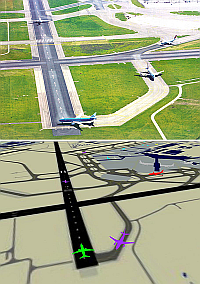Aircraft manoeuvres on airports range from arrivals, departures to towings and pushbacks. All these movements take place in a limited space and can lead to bottlenecks. In order to ensure that the ground infrastructure at Schiphol will continue to operate efficiently, even when traffic numbers increase, potential bottlenecks should be resolved as early as possible. The Increased Groundhandling Capacity Schiphol project made an inventory of potential bottlenecks, designed several possible solutions and validated their effectiveness using fast-time simulation.
The aim of the project
The project Increased Groundhandling Capacity Schiphol focuses on pinpointing bottlenecks in the taxiway system, designing solutions and validating the effectiveness through simulations.
The challenge
Aircraft manoeuvres on airports range from arrivals, departures to towings and pushbacks. All these movements take place in a limited space and can lead to bottlenecks. In order to ensure that the ground infrastructure at Schiphol will continue to operate efficiently, even when traffic numbers increase, potential bottlenecks should be resolved as early as possible. Possible solutions to remove the bottlenecks are generally associated with significant investments and the execution can seriously impact operations. Sound research is required to prove the effectiveness of those solutions to justify the required investments.
The approach
 The project Increased Groundhandling Capacity has researched the problem in three stages: identification of bottlenecks, designing solutions and validating the effectiveness through simulations.
The project Increased Groundhandling Capacity has researched the problem in three stages: identification of bottlenecks, designing solutions and validating the effectiveness through simulations.
During brainstorm sessions with operational experts of Air traffic Control The Netherlands (LVNL), Amsterdam Airport Schiphol (AAS) and Royal Dutch Airlines (KLM) the bottlenecks on Schiphol were identified. Five of these problem areas are given top priority.
One or more solutions have been developed for each of these top priority areas. The solutions are a combination of a local change of the ground infrastructure and corresponding procedures for traffic handling.
Finally, an overview is made of the costs and benefits of the different solution designs. In separate paths the investments of the different designs were determined and their effectiveness analysed through simulations.
The results
The seriousness of the problems, as well as the costs and effectiveness of the solutions were defined in this research. the effectiveness of the solutions were quantified using fast time simulations. The results can be the basis for future investments on Schiphol. Below a computer animation depicts the simulation of one of the areas of interest: the runway entries of runway 18L (Aalsmeerbaan).
{flv}case20_48_2_24|640|563{/flv}
Animation: Simulation departing aircraft from runway 18L (Aalsmeerbaan)
